|
|
|
|
|
|
|

Scientific/Technical Translations,
Ernst-Bloch-Ring 30,
D-07743 Jena, Germany
E-Mail:

Homepage: http://michael-basler.net
USt.-ID./T.V.A.: DE 188 402 537
- Patent applications in the fields of computer hardware/software, electronics, automotive, physics, and technology in general.
- Text books as well as popular science books in the fields of physics, mathematics, astronomy (including typesetting e.g. with LaTeX, it required).
- General technical texts like manuals, standards etc.
Language combination
English into German
Experience
I have been translating science books besides my work at university
since 1991. I have been working as a full time translator since
1997. For more detail see my
CV.
References
I can look back onto more than 2500 translated patent
applications, specifications, or sets of claims for various agencies and patent
attorney's offices. The following is a list of books I translated
up to now. While I highly recommend all of them I may be not free
of bias, though.
A. Linde, Elementarteilchen und inflationärer Kosmos, Spektrum Akademischer Verlag, Heidelberg, Berlin, Oxford, 1993, ISBN 3-86025-036-1. (from the Russian), Original Title: Fisika elementarnych castic i inflacionnaja kosmologia, Nauka, Moskva, 1990.
A comprehensive treatment of the concept of the inflationary cosmos, having been developed by Prof. Linde himself. While it's written in the style of a text book it is actually close to a monograph. The text is didactically very well done, however, you sure need quite a certain background on general relativity and quantum field theory to really comprehend it.
 S.
L. Sallas, E. Hille, Calculus, Einführung in die Differential-
und Integralrechnung, Spektrum Akademischer Verlag, Heidelberg,
Berlin, Oxford, 1994, ISBN 3-86025-130-9.
(from the American, translated together with T. Lange and K. H.
Lotze) Original Title: Calculus, John Wiley & Sons,
Inc. 1990.
S.
L. Sallas, E. Hille, Calculus, Einführung in die Differential-
und Integralrechnung, Spektrum Akademischer Verlag, Heidelberg,
Berlin, Oxford, 1994, ISBN 3-86025-130-9.
(from the American, translated together with T. Lange and K. H.
Lotze) Original Title: Calculus, John Wiley & Sons,
Inc. 1990.
I have been told this is a classical text on US universities, and that's probably right. It's a didactic masterpiece, enclosing just the necessary basics to comprehend Calculus. All less important stuff is omitted, but a lot of examples are presented. Contrary to some other "lower level" introductions all proofs are given, or at least sketched. I'd highly recommend it.
D. W. Jordan, P. Smith, Mathematische Methoden für die Praxis, Spektrum Akademischer Verlag, Heidelberg, Berlin, Oxford, 1996, ISBN 3-86025-359-X. (from the English) Original Title: Mathematical Technique. An Introduction for the Engineering, Physical and Mathematical Sciences, Oxford University Press 1994.
This book describes the main mathematical techniques used by
engineers in their everyday life. It just presents the recipes
and a lot of examples while only few proofs are given. I found
a very valuable aspect a disk provided with the German book (to
be ordered separately by readers of the original version) including
30 ready-to-run example Mathematica (©) programs.
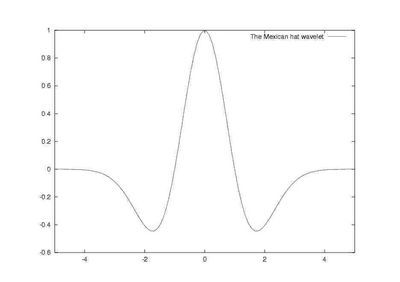 B.
Burke Hubbard, Wavelets, Birkhäuser Verlag, Basel, Boston, Berlin,
1997, ISBN 3-7643-5688-X.
(from the American) Original Title: The World According to Wavelets:
The Story of a Mathematical Technique in the Making, A K Peters,
Ltd., Wellesley, MA 1995.
B.
Burke Hubbard, Wavelets, Birkhäuser Verlag, Basel, Boston, Berlin,
1997, ISBN 3-7643-5688-X.
(from the American) Original Title: The World According to Wavelets:
The Story of a Mathematical Technique in the Making, A K Peters,
Ltd., Wellesley, MA 1995.
Wavelets are a fascinating generalization of the well-known Fourier transformation technique, providing a trade-off between representing a signal in space or in frequency only. However, wavelets are not at all for mathematicians only - some very effective file compression methods are based on them, to name only one application.
The first half of this popular treatment - which anyone interested in math should be able to comprehend - is free of any formulas at all. Even the second half being written "In the language of mathematics" should be comprehensible by anyone with a basic education in math - not necessarily involving calculus. You can find a lot of references by workers on their work in the field - sometimes naturally controversial - throughout the book. I'd be glad if the reader would enjoy reading it the same way I enjoyed translating it.
Professionelle Schaltungstechnik, Band 6, Franzis'-Verlag, München, 1997 (from the American) Original Title: Rudolf F. Graf, Encyclopedia of electronic circuits, Vol. 2, TAB BOOKS Inc., Blue Ridge Summit, PA, 1988.
This is vol. 6 of an eight volume comprehensive and successful
Encyclopedia of electronic circuits edited by Franzis'. It contains
more than 700 circuit diagrams together with more or less detailed
descriptions. You will find nearly all kinds of circuits one can
imagine - starting from alarm circuits, converters, oscillators,
receivers up to touch switch circuits. While the subject is probably
not this exciting as wavelets, it will sure be a valuable tool
for those actually having to assemble a certain device.
T. W. Körner: Mathematisches Denken. Vom Vergnügen am Umgang mit Zahlen, Birkhäuser Verlag, Basel, Boston, Berlin, 1998, ISBN 3-7643-5833-5 (from the English) Original Title: The Pleasures of Counting, Cambridge University Press, 1996.
The main goal of this 700pp volume book is showing how mathematicians
are doing mathematics. It is not a text book of completed mathematics
but rather shows mathematics in its making. This is done by presenting
five large areas where math has been useful. Examples range from
the use of statistical methods (The appearance of epidemics...)
via mathematical formulation of physical law (Special relativity...)
algorithms, cryptology (The math of the enigma...) to differential
equations (Growth and decay...). This presentation is a masterpiece
and really fun reading. Moreover, if you have a closer look into
this book, you may even detect several hints which might prove
useful for your life beyond math.
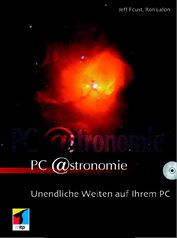 Jeff
Foust, Ron Lafon: PC @stronomie: Unendliche Weiten auf Ihrem PC,
mitp-Verlag, Bonn, 2000, ISBN 3-8266-0618-3
(from the American) Original Title: Astronomer's Computer Companion,
no starch press, San Francisco, 2000.
Jeff
Foust, Ron Lafon: PC @stronomie: Unendliche Weiten auf Ihrem PC,
mitp-Verlag, Bonn, 2000, ISBN 3-8266-0618-3
(from the American) Original Title: Astronomer's Computer Companion,
no starch press, San Francisco, 2000.
Do you belong to those people, like me, with a life-long weakness for the starry night? Or, are you even an avid amateur astronomer spending every other night on the telescope? If so, you really should consider getting this book. Its aim is showing the connection between astronomy and (Personal) Computers. Indeed, there are already numerous connections - you only have to find them. Astronomer's Computer Companion helps you to localize astronomy stuff on your PC as quickly and simply as possible.
The first third of the book is a complete introduction to astronomy
which starts with our earth and ends up with black holes, quasars,
and the like. Contrary to similar presentations, all the material
is mixed with numerous links to relevant Internet pages and hints
to useful astronomy programs. The second part is a systematic
outline of on-line and off-line resources in astronomy including
newsgroups, on-line services, search engines and the like on the
one hand side and planetarium programs, satellite tracking software
and observational programs and such on the other hand.
The last third is an extended appendix with reference to the accompanying
CD-ROM - a jewel in its own. It contains more than a hundred Freeware,
Shareware and Demo versions of astronomy software plus an extended
collection of stunning pictures and animations from the Hubble
Space Telescope and other sources. Not enough, the CD-ROM contains
the complete book as a .pdf file with click-able links! No need
to type in all those weird http://&%$ addresses by hand.
Jan Axelson: USB Professionell, mitp-Verlag, Bonn, 2001, ISBN 3-8266-0698-1 (from the American, translated together with G. Franken) Original Title: USB Complete - Everything You Need to Develop Custom USB Peripherals, Lakeview Research, 1999.
This book is from the times of emerging USB interface. While USB specification was defined as early as in 1996, it took nearly three more years for USB interfaces (the small flat jacks on your PC) being integrated into standard PCs by default and USB peripherals becoming more widely used.
The Book is not so much written for the end user of USB devices while its focus is aimed on developers and programmers. After an introduction into the goals of the USB the books explains data transfers modes and protocols. Next, you'll find an example for the selection of the proper controller chip for your device. Finally, the book describes test procedures for the newly developed devices and software. Further chapters concentrate on concrete programming of the firmware for a device. While the focus of the representation is on Windows as the operating system, the German edition contains several additions on Linux as well.
Source code for the example programs - which can be taken as a basis for modification - is included on a CD-ROM. One of the advantages of the book is its clear organization. This makes it easy for the practitioner as the main target of the book to find relevant information quickly.
.gif) Philip
S. Harrington: Sonnen- und Mondfinsternisse beobachten, Spektrum
Akademischer Verlag, Heidelberg, 2002, ISBN 3-8274-1329-X
(from the American) Original Title: Eclipse! The What, Where, When,
Why & How Guide to Watching Solar & Lunar Eclipses, John Wiley
& Sons, New York, 1997.
Philip
S. Harrington: Sonnen- und Mondfinsternisse beobachten, Spektrum
Akademischer Verlag, Heidelberg, 2002, ISBN 3-8274-1329-X
(from the American) Original Title: Eclipse! The What, Where, When,
Why & How Guide to Watching Solar & Lunar Eclipses, John Wiley
& Sons, New York, 1997.
"Amongst all the wonders of the wonderful sciences there is no science which deals with such a gorgeous spectacle as is exhibited by the queen of sciences, astronomy, at the moment when the earth is gradually shrouded in darkness and when around the smiling orb of day there appears the matchless crown of the corona..." (S. A. Mitchell, Eclipses of the Sun, 1923). Few people can resist the fascination of eclipses, notably those of the sun.
This book is less a deep treatment of all the theoretical aspects
of eclipses (while it, of course, includes an introduction into
the celestial mechanics of such events). Instead, written by an
avid, if not addicted, observer of eclipses, it is brimful of
practical experience, tips, tricks etc. Anyone, who is going to
seriously watch eclipses, should have read this book, and, moreover,
should have it handy during his or her excursion.
Besides practical instructions on how to observe and/or photograph
eclipses, including long-time planning, the book comprises a complete
treatment of all eclipses, sun and moon, between 2001 and 2017.
Every treatment has a map of visibility, remarks on best places
to visit (occasionally, how to reach them), tables on contact
times, several tables on visibility in larger cities, and more.
(Graphics: Animation of total eclipse of the sun in 2006; Source: Wikipedia.org, Open Licence available under the link)
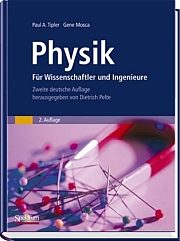 Paul
A. Tipler, Gene Mosca, Physik für Wissenschaftler und Ingenieure,
Spektrum Akademischer Verlag, Heidelberg, 2004, ISBN 3-8274-1164-5
(2nd German Edition)
(from the American, translated together with R. M. Dohmen, C.
Heinisch, W. Kuhn, A. Schleitzer, and M. Zillgitt)
Original Title: Physics for scientists and engineers,
W. H. Freeman and Co., New York and Basingstoke 2003.
Paul
A. Tipler, Gene Mosca, Physik für Wissenschaftler und Ingenieure,
Spektrum Akademischer Verlag, Heidelberg, 2004, ISBN 3-8274-1164-5
(2nd German Edition)
(from the American, translated together with R. M. Dohmen, C.
Heinisch, W. Kuhn, A. Schleitzer, and M. Zillgitt)
Original Title: Physics for scientists and engineers,
W. H. Freeman and Co., New York and Basingstoke 2003.
The "Tipler" is pretty much a (if not the) Standard Physics
Text for Engineering students. It is clearly written and famous
for its numerous examples and applications, engineering students
have been working with it ever since the first German edition
became available in the 1990s. After two more US Editions with
more or less complete re-arrangement (and re-rearrangement) of
material, a new German edition was due. This is one of the up-to-date
four-colour representations excelling in plain examples, try-it-yourself-examples,
put-it-in-context-Examples, practice problems, and more. Examples
have a two-column representation, where you can hide the calculations
on the r.h.s. and try them yourself along the verbal hints on
the l.h.s., before comparing.
Indeed, typesetting of this book (which was essentially done by
the translators, with only a final conversion step by typesetters)
with its four-colour-representation and numerous special elements
and formulas using LaTeX was a real challenge. But I think the
result is promising. At least my younger son, as an engineering
student himself, enjoyed it.
David Mills et al. Arbeitsbuch zu Tipler/Mosca, Physik für Wissenschaftler und Ingenieure, Spektrum Akademischer Verlag, Heidelberg, 2005, ISBN 3-8274-1165-3 (2nd German Edition) (from the American, translated together with M. Zillgitt) Original Title: Instructor's Solutions Manual for Tipler/Mosca's Physics for Scientists and Engineers, W. H. Freeman and Co., New York and Basingstoke 2004.
The Tipler textbook (see above) includes a host of problems without solutions. These include simple questions to check understanding of the concept (A ball is thrown straight up. What is the velocity of the ball at the top of its flight?) up to problems needing several pages full of formula. This manual comprises complete and detailed solutions to all problems attached to the various chapters of the text book.
 Michael
F. Ashby, David R. H. Jones, Werkstoffe 1: Eigenschaften, Mechanismen
und Anwendungen, Spektrum Akademischer Verlag, Heidelberg, 2006,
ISBN 978-3-8274-1708-4
(from the English, translated together with C. Heinisch, B. Schäfer,
and M. Zillgitt) Original Title: Engineering Materials 1, Butterworth-Heinemann,
Burlington, 2005.
Michael
F. Ashby, David R. H. Jones, Werkstoffe 1: Eigenschaften, Mechanismen
und Anwendungen, Spektrum Akademischer Verlag, Heidelberg, 2006,
ISBN 978-3-8274-1708-4
(from the English, translated together with C. Heinisch, B. Schäfer,
and M. Zillgitt) Original Title: Engineering Materials 1, Butterworth-Heinemann,
Burlington, 2005.
This is one of the classical textbook (1st English Edition
in 1980) on materials science. It starts with a treatment of atomic
bond and the structure of solids. Based on this, it concentrates
on elastic moduli (Young's modulus etc.) and includes topics like
yield strength and tensile strength, brittle fracture, toughness,
fatigue failure and all those properties an engineer needs to
know when selecting materials for a special purpose. Included
are chapters on oxidation and corrosion as well as friction, abrasion
and wear. Notably, the book contains a treatment of economic aspects
like price and availability of certain materials, quite at the
beginning.
Although I am not an engineer myself, I found the presentation
indeed well-done and balanced and moreover well-written (which
I wouldn't say of all engineering texts). Notably, I enjoyed the
"case studies" at the end of each chapter presenting a few practical
problems in context (like selection of a material for a telescope
mirror in chapter 7).
 Paul
A. Tipler, Gene Mosca: Physik für Wissenschaftler und Ingenieure,
Spektrum Akademischer Verlag, Heidelberg, 2009, ISBN 978-3-8274-1945-3
(6th Edition)
(from the American, translated together with R. M. Dohmen, C.
Heinisch, A. Schleitzer, and M. Zillgitt)
Original Title: Physics for scientists and engineers,
W. H. Freeman and Co., New York and Basingstoke 2008.
Paul
A. Tipler, Gene Mosca: Physik für Wissenschaftler und Ingenieure,
Spektrum Akademischer Verlag, Heidelberg, 2009, ISBN 978-3-8274-1945-3
(6th Edition)
(from the American, translated together with R. M. Dohmen, C.
Heinisch, A. Schleitzer, and M. Zillgitt)
Original Title: Physics for scientists and engineers,
W. H. Freeman and Co., New York and Basingstoke 2008.
This is the translation of the most recent English Edition of the standard physics textbook. Essential parts were re-worked or completely new translated. There is again an accompanying text of problems and solutions:
David Mills: Bachelor-Trainer Physik, Spektrum Akademischer Verlag, Heidelberg, 2010, ISBN 978-3-8274-2049-7 (from the American, translated together with M. Zillgitt) Original Title: Solutions manual for Tipler/Mosca Physics 6e / Tipler: Physics 6e webassign edition i-clicker questions, Worth Publishers, New York and Basingstoke, 2008
 Neil F. Comins:
Astronomie, Spektrum
Akademischer Verlag, Heidelberg
2011, ISBN
978-3-8274-2498-3 (from the
American, translated together
with A. Schleitzer, and M.
Zillgitt)
Discovering the Essential
Universe, W. H. Freeman and Co.
New York and Basingstoke 2009,
4th Edition
Neil F. Comins:
Astronomie, Spektrum
Akademischer Verlag, Heidelberg
2011, ISBN
978-3-8274-2498-3 (from the
American, translated together
with A. Schleitzer, and M.
Zillgitt)
Discovering the Essential
Universe, W. H. Freeman and Co.
New York and Basingstoke 2009,
4th Edition
Comins gives a comprehensive outline of present day Astronomy, nearly without any formula. He starts with observational Astronomy, makes a journey though our Solar System with an in-depth representation of the planets, describes the life of stars from birth to death and closes with a sketch on Galaxies and Cosmology. Certainly, this book is not for the student of Astronomy who already should have a working knowledge in mathematics. However, anyone wanting to just learn on the heaven around us and the physical laws acting therein in a less formal way may enjoy this book. Adding to its value are numerous colour images, i.e. photographs, graphs, and stellar charts making it visually pleasing, too.
 Frank
Close: Neutrino, Springer
Spektrum, Heidelberg, 2012, ISBN 978-3-8274-2940-7
(from the English)
Original Title: Neutrino,
Oxford University Press., Oxford, UK 2010.
Frank
Close: Neutrino, Springer
Spektrum, Heidelberg, 2012, ISBN 978-3-8274-2940-7
(from the English)
Original Title: Neutrino,
Oxford University Press., Oxford, UK 2010.
Ask a random person what he knows about the "neutrino". Chances are the answer will be "nothing". Indeed many heard about electrons, protons, and neutrons, but never about the neutrino. One reason may be that the neutrino is indeed subtle - neither does it have a mass nor does it engage in strong interactions - just the proper particle to overlook. Despite this fact, neutrinos are very important for our understanding of elementary particles and their interactions. The neutrino is an essential building block in Salam-Weinberg's theory of unification of electromagnetic and weak interactions.
This is a popular science text on the history of the prediction of the neutrino and the hard way of its experimental verification with a special emphasis on the solar neutrino problem and its solution. Close is an eminent particle physicist who was involved in neutrino research himself who doubles as a splendid science writer. Actually, the text grew out of an awarded essay on neutrino researcher Raymond Davis. This way it is indeed a pleasure to read, not only for pupils or teachers, but even for the physicist.
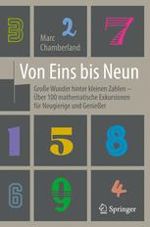 Marc
Chamberland:
Von Eins bis Neun, Große Wunder
hinter kleinen Zahlen, Springer-Verlag, Berlin Heidelberg
2016, ISBN
978-3-662-50250-1 (from the
American)
Original Title:
Single Digits, Princeton
University Press 2015
Marc
Chamberland:
Von Eins bis Neun, Große Wunder
hinter kleinen Zahlen, Springer-Verlag, Berlin Heidelberg
2016, ISBN
978-3-662-50250-1 (from the
American)
Original Title:
Single Digits, Princeton
University Press 2015
Number theory is a complex subject. Instead of a systematic approach, the booklet takes the single-digit numbers from 0 to 9 as a showcase to present a number of perplexing and puzzling applications. In how many ways can you factor any numer into prime numbers? There is only one way. Why are four colors always sufficient to color a map so that no two adjacent regions share the same color? Why do eight perfect card shuffles leave a deck of cards completely unchanged? Each chapter is devoted to one single-digit number, starting with simple statements but climbing to some really complex ones towards the end. So, if you are lost somewhere in-between, you can just jump to the next number-chapter to start anew.
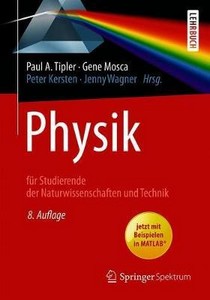 Paul
A. Tipler, Gene Mosca: Physik für Studierende der Naturwissenschaften
und Technik,
Springer Spektrum, Heidelberg, 2019, 978-3-662-58280-0
(8th Edition)
(from the American, translated together with R. M. Dohmen, C.
Heinisch, A. Schleitzer, and M. Zillgitt)
Original Title: Physics for scientists and engineers,
W. H. Freeman and Co., New York and Basingstoke 2008.
Paul
A. Tipler, Gene Mosca: Physik für Studierende der Naturwissenschaften
und Technik,
Springer Spektrum, Heidelberg, 2019, 978-3-662-58280-0
(8th Edition)
(from the American, translated together with R. M. Dohmen, C.
Heinisch, A. Schleitzer, and M. Zillgitt)
Original Title: Physics for scientists and engineers,
W. H. Freeman and Co., New York and Basingstoke 2008.
The most recent edition of the extremly successful title. This one was edited and updated to better fit to the German Bachelor Curriculum. In addition, an eBook version is included and separately available (ISBN 978-3-662-58281-7).
Book covers with kind permissions from the respective publishers.
Online since 1997 - Latest update: 14 December 2023 - Datenschutzerklärung